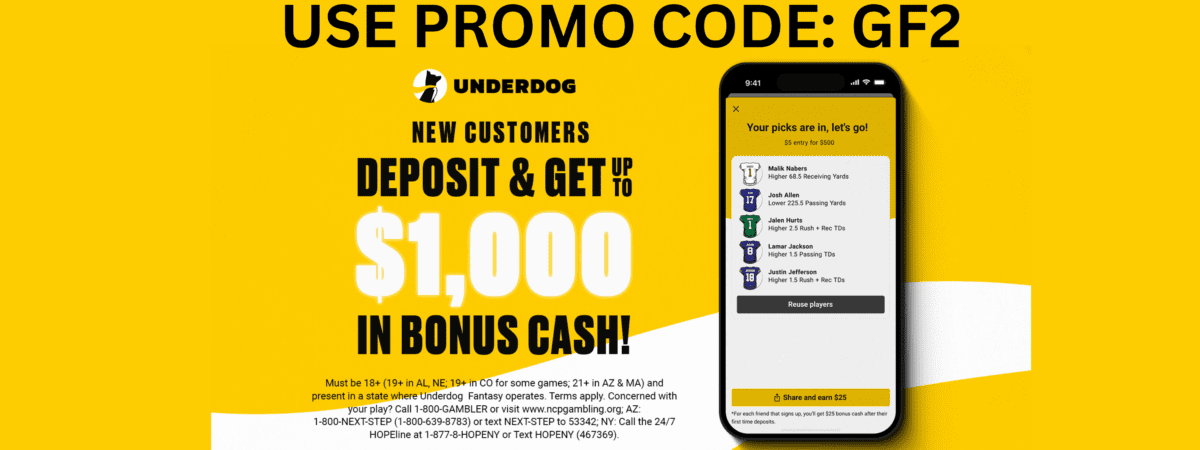Superflex Spotlight: The Differences in Draft Strategy
In the NFL, quarterback is the most important position on the field. For teams it’s all about finding a franchise quarterback. In fact, this year the NFL draft saw five quarterbacks taken in the first 15 picks. Superflex fantasy football leagues are like the NFL, the value on the quarterback position is sky-high. When you play in a superflex league, it’s paramount to shift your strategy from traditional (one-quarterback) leagues to make sure you don’t miss out on your franchise quarterbacks.
For readers new to superflex leagues, here is how they work. The starting lineup settings are defined with an additional position called an all-flex or super-flex. The all-flex position adds the option to start a quarterback in place of the normal flex options of running back, wide receiver, or tight end. It’s a format that has grown significantly over the years. In fact, the wildly popular Scott Fish Bowl charity tournament uses the superflex format.
Embed from Getty ImagesSo, how exactly should you approach superflex leagues? This article will explain why to value quarterbacks more in superflex and draft strategy in superflex leagues versus one-quarterback leagues.
Quarterback Average Draft Position
First, let’s take a look at how the average draft position (ADP) values change in superflex leagues. Patrick Mahomes is the consensus number one quarterback in dynasty fantasy football. In start-up drafts for one-quarterback leagues, Mahomes’ ADP is position 29. In contrast, ADP for Patrick Mahomes in superflex is number one overall. To emphasize, Baker Mayfield’s ADP in one-quarterback is 155, as the 19th quarterback off the board. In superflex, he climbs all the way to pick 38, a drastic nine-round difference.

On average, around 31 quarterbacks are selected in the top 100 players in superflex. Compare that to only ten quarterbacks in the top 100 in standard one-quarterback leagues. The takeaway here is you should be prepared to select a quarterback, or two, early in drafts. The option to start a second quarterback is too good to pass up, thus you need to equip your team with at least two great quarterback options.
Embed from Getty ImagesAlways Start a Quarterback in your Superflex
I know what you’re thinking, “I don’t need to start two quarterbacks, I’ll just roll with running backs and wide receivers in my superflex spot”. I would advise against this, and here is why.
Simply put, quarterbacks score more points compared to the other positions and in a more consistent manner. Alvin Kamara, the top-scoring running back in 2020, ranked seventh in points overall behind the six top quarterbacks. The better comparison between positions comes in the range of players you will choose from for your superflex position. Assuming you start two wide receivers and two running backs, your choice for a flex conservatively starts in the range of 49th through 60th for non-quarterbacks. A second quarterback would be in the range of 13th to 24th.

As you can see, that range of quarterbacks averages more than four points a game than your average flex running backs, wide receivers, and tight ends. Let’s take it one step further. Let’s say your team has better options at flex for non-quarterback positions and slightly worse options at quarterback. Here is how average points per game stack up using quarterbacks 13 to 28 from last year and non-quarterbacks from 37 to 60.

Quarterback once again averages more points, this time over two points a game. In leagues where you start more running backs and wide receivers, this disparity would actually grow. In almost all cases, any starting quarterback is likely to score more than your average flex player, so you are in far better shape with high-quality quarterback options for your superflex position.
Quarterback Depth
So we know we want to start two quarterbacks in our lineup, but how many viable options are there at quarterback? The value of the quarterback position increases, even more, when you factor in the current depth and talent at the position.
At this moment, the quarterback position is experiencing a changing of the guard. An influx of new play-callers has emerged including Justin Herbert, Patrick Mahomes, and Josh Allen. While veteran quarterbacks like Drew Brees, Philip Rivers, Ben Roethlisberger, and Tom Brady have retired or will retire sooner than later. Additionally, there are a number of quarterbacks that I view as short-term options in Dynasty Fantasy Football. In other words, I feel as though these quarterbacks have a better than normal chance of being replaced in the next year or two. The quarterbacks I include in this group are; Matt Ryan, Derek Carr, Kirk Cousins, Jared Goff, and Carson Wentz.
Embed from Getty ImagesIf you factor in rookies that haven’t broken out yet and young players like Daniel Jones or Drew Lock, it gets tough to name 16 quarterbacks you are confident will be starting quarterbacks in two years. The value of top-tier quarterbacks has never been higher. So approach your drafts with this in mind.
Love our content? Check out the GoingFor2 Live Podcast Network!
Dynasty Startup Draft Strategy
One-Quarterback Leagues
In one-quarterback leagues, it is all about patience when selecting a quarterback. As we noted earlier, quarterbacks go off the board later in drafts. Patrick Mahomes is often selected at the end of round two. In ten and twelve team leagues, the quarterback position is deep enough that one can get a viable starter by waiting. Quarterbacks like Matt Stafford and Ryan Tannehill can still be selected after the top quarterbacks are off the board. Top-end wide receivers and especially running backs should be what you focus on in the early rounds.
Embed from Getty ImagesIn deeper leagues, featuring 14 or more teams, I would recommend prioritizing quarterback more. You can still wait but the position thins out quicker with extra teams involved. I would prefer to secure a safe quarterback rather than gamble on the more questionable options in the 14 to 17 range of quarterback rankings. Ideally, you can do this without reaching too far and still grab top-end running backs and wide receivers upfront.
Superflex Leagues
My advice in superflex leagues, plan to select your first quarterback in rounds one or two and your second quarterback by round six. However, remember no two drafts are the same. Be prepared to adapt if the draft doesn’t happen as expected. For example, if you select a quarterback in round one, but quarterbacks aren’t flying off the board, you may time your second quarterback differently. Trading during your start-up can also help. A trade-up may allow you to select a top-end quarterback if a run on quarterback starts. Trading down can render extra value when you’ve secured your quarterbacks early and other teams are scrambling.
In general, I wouldn’t recommend hoarding quarterbacks at the expense of other positions. However, keep in mind, it never hurts to have as many viable options at quarterback as possible. I’ve seen dynasty teams that appear safe at quarterback suddenly end up quarterback-needy in a short period of time. Ask a team manager who rostered Jameis Winston, Marcus Mariota, or Carson Wentz how they feel about their quarterback situation now.
Rookie Draft Strategy
Dynasty rookie rankings vary considerably between superflex and one-quarterback formats. Superflex rookie drafts often feature five quarterbacks selected in the first round, whereas Trevor Lawrence is usually the lone first-round quarterback in one-quarterback leagues.
Embed from Getty ImagesOne-Quarterback Leagues
In one-quarterback leagues, you can focus your attention on the top running backs or wide receivers in the rookie draft. This year’s second or third-round picks are good enough to select Zach Wilson, Justin Fields, or Mac Jones if needed. A small price to pay to add quality quarterback depth to your squad.
Additionally, you can focus on less quarterback prospects. This year you can most likely pick up Kellen Mond or Kyle Trask off waivers in the future. Use your round three and four picks on high upside running backs, wide receivers, or tight ends.
Superflex Leagues
It’s essentially a requirement to have a top-five pick in superflex to select a top-tier rookie quarterback. Thus, the strategy for teams looking to upgrade with young quarterback talent starts in a season. Draft capital in future rookie drafts is vital for rebuilding teams looking to overhaul their quarterback room. Obtaining a quality quarterback any other way is very expensive. Trading directly for a great quarterback or a top draft will cost you dearly. Trust me, try to trade for Justin Herbert right now, let me know how it goes.
Embed from Getty ImagesMake sure you’ve done your homework on the quarterbacks ranked lower in the class and draft them appropriately. Mond and Trask won’t make it to waivers in superflex, so evaluate using third or fourth-round picks to select a quarterback with potential down the line.
Finally, in a rookie draft, even if your team is set at quarterback, I would still recommend drafting a quarterback if they are the best player available. Let’s say a team has the second overall pick this year and has Justin Herbert, Joe Burrow, and Matt Stafford at quarterback. That team should still draft Justin Fields, or their preferred quarterback, with the second pick. Outside of trading the pick for a significant return, take the best player available, add the depth at quarterback and look for trades later. Worst case scenario your team is super solid at quarterback. Don’t forget superflex is like the NFL, quarterback is king.
ATTN Dynasty Commissioners: Do you want to do something cool for your league? How about a 1-hour live show dedicated to YOUR league? Team-by-team breakdowns, rankings, and more. For details and to book a show, visit: GoingFor2.com/plp.






